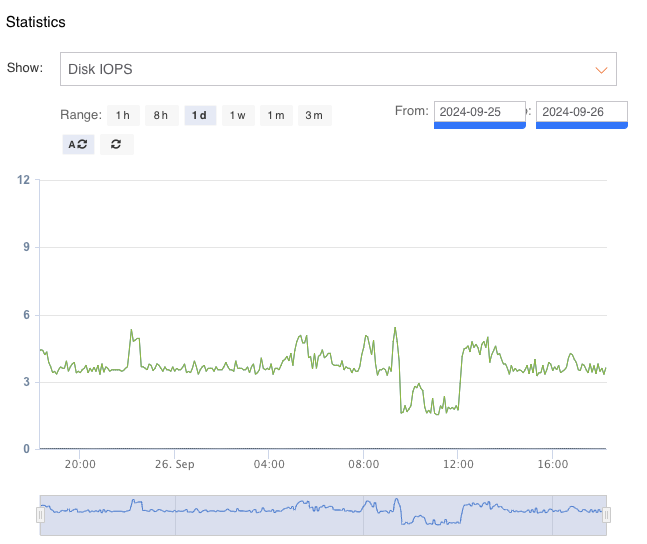Disk IOPS
Monitoring Disk IOPS (Input/Output Operations Per Second) is essential for assessing the performance and efficiency of your storage resources. This section provides guidance on how to access, interpret, and analyze disk IOPS metrics.
Accessing Disk IOPS Metrics
To view Disk IOPS data for your cloud resources, follow these steps:
-
Navigate to the Monitoring Dashboard:
- Log in to your cloud platform.
- Go to the Monitoring section from the main menu.
- Select Disk IOPS from the list of available metrics.
-
Set the Time Range:
- Utilize the Range buttons (1h, 8h, 1d, 1w, 1m, 3m) to specify the time frame for your analysis.
- For a custom range, choose the desired From and To dates.
Understanding Disk IOPS Graph
The Disk IOPS graph visually represents the number of input/output operations performed on the disk over the selected time period.
- Y-axis: Indicates Disk IOPS.
- X-axis: Displays the timeline of the selected range.
Interpreting the Graph
- Monitor the graph for trends and fluctuations in disk activity to identify periods of increased usage.
- Significant spikes can indicate high demand on disk resources, which may affect application performance.

Disk IOPS Statistics Overview
In addition to the graphical representation, the statistics table provides detailed metrics on disk IOPS:
| Metric | Minimum | Maximum | Total |
|---|---|---|---|
| Disk Command Total | 0.00 cmd/s | 12.00 cmd/s | 15515.00 cmd/s |
| Disk Read Total | 0.00 cmd/s | 0.00 cmd/s | 0.00 cmd/s |
| Disk Write Total | 0.00 cmd/s | 12.00 cmd/s | 15515.00 cmd/s |
| Disk #1 Commands | 0.00 cmd/s | 12.00 cmd/s | 15515.00 cmd/s |
| Disk #1 Read | 0.00 cmd/s | 0.00 cmd/s | 0.00 cmd/s |
| Disk #1 Write | 0.00 cmd/s | 12.00 cmd/s | 15515.00 cmd/s |
Note: Statistics data is based on 1-minute average aggregated samples.
Analyzing Disk Performance
- Minimum: The lowest recorded disk IOPS during the specified period.
- Maximum: The peak disk IOPS, indicating the highest demand.
- Total: The cumulative number of disk I/O operations performed during the selected timeframe.
Best Practices for Monitoring Disk IOPS
- Regular Reviews: Frequently check Disk IOPS trends to proactively manage storage resources and performance.
- Investigate Spikes: Look into any significant increases in disk IOPS to identify potential bottlenecks or inefficient processes.
- Resource Allocation: Adjust disk configurations or storage plans based on observed I/O patterns to optimize performance.